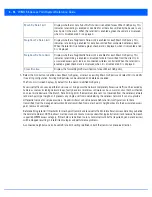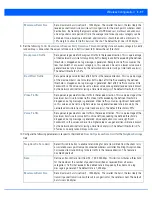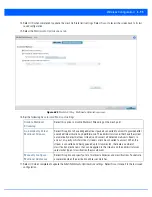
6 - 86 WiNG 5.6 Access Point System Reference Guide
6.5.1 Smart RF Configuration and Deployment Considerations
SMART RF
Before defining a Smart RF supported configuration, refer to the following deployment guidelines to ensure the configuration
is optimally effective:
• Smart RF is not able to detect a voice call in progress, and will switch to a different channel resulting in voice call
reconnections
• The Smart RF calibration process impacts associated users and should not be run during business or production hours. The
calibration process should be performed during scheduled maintenance intervals or non-business hours.
• For Smart RF to provide effective recovery, RF planning must be performed to ensure overlapping coverage exists at the
deployment site. Smart RF can only provide recovery when access points are deployed appropriately. Smart RF is not a
solution, it's a temporary measure. Administrators need to determine the root cause of RF deterioration and fix it. Smart RF
history/events can assist.
Motorola Solutions recommends that if a Smart RF managed radio is operating in WLAN mode on a channel requiring DFS, it
will switch channels if radar is detected.
• If Smart RF is enabled, the radio picks a channel defined in the Smart RF policy.
• If Smart RF is disabled, but a Smart RF policy is mapped, the radio picks a channels specified in the Smart RF policy
• If no SMART RF policy is mapped, the radio selects a random channel
If the radio is a dedicated sensor, it stops termination on that channel if a neighboring access point detects radar. The access
point attempts to come back to its original channel (statically configured or selected by Smart RF) after the channel evacuation
period has expired.
Change this behavior using a
no dfs-rehome
command from the CLI. This keeps the radio on the newly selected channel
and prevents the radio from coming back to the original channel, even after the channel evacuation period.
Summary of Contents for WiNG 5.6
Page 1: ...Motorola Solutions WiNG 5 6 ACCESS POINT SYSTEM REFERENCE GUIDE ...
Page 2: ......
Page 22: ...8 WiNG 5 6 Access Point System Reference Guide ...
Page 26: ...1 4 WiNG 5 6 Access Point System Reference Guide ...
Page 38: ...2 12 WiNG 5 6 Access Point System Reference Guide ...
Page 74: ...3 36 WiNG 5 6 Access Point System Reference Guide ...
Page 468: ...6 2 WiNG 5 6 Access Point System Reference Guide Figure 6 1 Configuration Wireless menu ...
Page 568: ...6 102 WiNG 5 6 Access Point System Reference Guide ...
Page 614: ...7 46 WiNG 5 6 Access Point System Reference Guide ...
Page 660: ...8 46 WiNG 5 6 Access Point System Reference Guide ...
Page 716: ...9 56 WiNG 5 6 Access Point System Reference Guide ...
Page 730: ...10 14 WiNG 5 6 Access Point System Reference Guide ...
Page 982: ...14 20 WiNG 5 6 Access Point System Reference Guide ...
Page 984: ...A 2 WiNG 5 6 Access Point System Reference Guide ...
Page 1046: ...B 62 WiNG 5 6 Access Point System Reference Guide ...
Page 1047: ......
















































